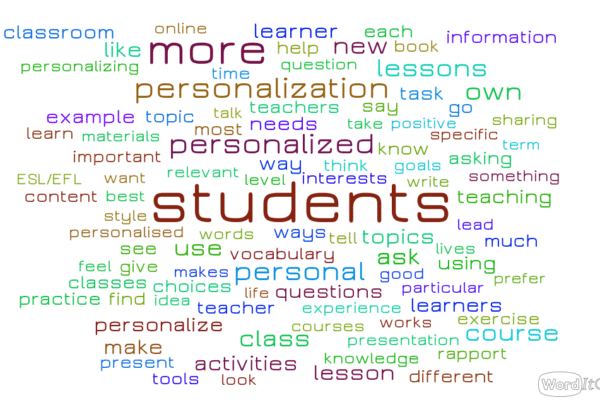Do instructions have to be that dull?
Instructions are an important part of every teacher’s life. They can either make or break our lessons, getting students in the best mood imaginable or sending them into a downward spiral of discontentment (has anyone ever heard students react with sighs of “reading again?”). How can we guarantee that the second doesn’t happen?
Imagine a teacher who has an elementary group of adults and wants to help his learners develop listening skills. Now look at the instructions that our imaginary and well-intentioned teacher delivered in one lesson to that group. How effective do you think they were?
T: Ok, guys, now work in pairs and talk about two types of food that you like.
[Students do so]
T: Great! Very good! Now we are going to do a listening. We’ll listen to a girl talking about her favourite type of food. Listen [Teacher touches his/her right ear with her finger to reinforce meaning] and make notes, please [Teacher mimes the action of writing]. What is her favourite type of food? OK?
[Students nod]
T: Do you have to listen or read?
Ss: Listen.
T: Do you have to work in pairs or individually?
Ss: Individually.
So? What do you think?
Now look at what happened in another teacher’s lesson to a similar group and decide which option is closer to your heart:
T: Maria, do you like Italian food?
Maria: Yes.
T: And do you think João likes Italian food?
Maria: I don’t know.
T: Go ahead. Ask João.
Maria: João, you like Italian food? (sic)
João: Yes! I like pizza.
T: And João, what do you think Fernanda’s favourite type of food is?
João: I think salad. (sic)
T: Did he get it right, Fernanda?
Fernanda: [laughs] No! I hate salad.
T: Sorry João…bad luck! Now everyone, look at the people in your group and try to guess their favourite type of food.
[Students try to guess, asking questions]
T: Thank you! Ricardo, look at the picture of the girl on page 25. [Ricardo opens the book on page 25]. Imagine you want to have a romantic dinner with her. Is it important to know what type of food she likes?
Ricardo: Yes. Of course.
T: So what do you think is her favourite type of food?
Ricardo: Ok. I think she likes Japanese. (sic)
T: And why is that?
Ricardo: Ah! Because she’s Japanese!
[Some students and the teacher laugh]
T: Do you guys agree with Ricardo?
[Some students agree and some disagree]
T: Well, let’s listen to her and check if Ricardo is right? We’re going to listen to her only once, ok? So what do we have to pay attention to, Priscilla?Priscilla: The type of food she likes.
T: Fantastic! Let’s listen?
To be honest, I find the latter much more interesting. The second teacher took longer to introduce the task, granted. But I believe the level of personalisation, student participation and engagement make up for it.
Curiously enough, the first set of instructions did follow the general advice of teacher trainers and methodology books: they were short, direct, graded according to the level and checked using ICQs. That means they are ‘appropriate’, right? From a different perspective, however, they can be seen as impersonal, meaningless and…well…boring, really!
If I were to give advice to teacher number one, this is what I would say:
1. Sell the task you are going to propose
Instructions aren’t simply a moment in which the teacher tells students what to do. They are the moment in which teachers show students the relevance of what they will do and convince them to do it. In the second example above, the teacher involved students in a meaningful conversation on the topic beforehand, asked them personal questions, prompted student-student interaction and raised interest by asking learners to predict and check their predictions, a whole different game from just doing what is “in the programme”.
2. Avoid narrating steps
My experience tells me that when you start instructions with “Now we’re going to do a listening (or reading, or game etc.)” is usually the moment in which part of your group loses interest, not because the activity you designed is boring per se, but rather because you spoiled the surprise. If I may use an odd analysis, imagine the person sitting opposite you on a first date suddenly saying: “Now, I’m going to hold your hand.” Awkward, isn’t it?
3. Check what needs to be checked
Instruction-checking questions (ICQs) are a powerful classroom tool. They can help learners be certain of what they are expected to do and may help teachers ensure that nobody is left behind, as well as evaluate their own instruction-giving. So much so that most serious teacher-training courses and books dedicate some space to them. However, look again at the ICQ “Do you have to listen or read?” in the first example above, in which the teacher had already told students they were going to ‘do a listening’. Don’t they sound rather patronising (or even verge on nonsensical)?
4. Use students
Learners are the main stars in the learning process, aren’t they? So let them take on this role and participate more actively, even during instructions: use their names; treat them as individuals rather than as a mass; allow them to predict what they will have to do based on the layout of the exercise (a simple “What do you think you have to do in this exercise?” could be way more interesting than “Could you please read the instructions of exercise five?”); let them share strategies they could use to be more successful and so on.
A lot can be done in order to make our lessons more engaging and interesting through instructions. Most of the ideas above will inevitably require us to set aside the ‘control freak’ within us and share our traditional ‘power’ with students. To my eyes, it’s well worth a try.






